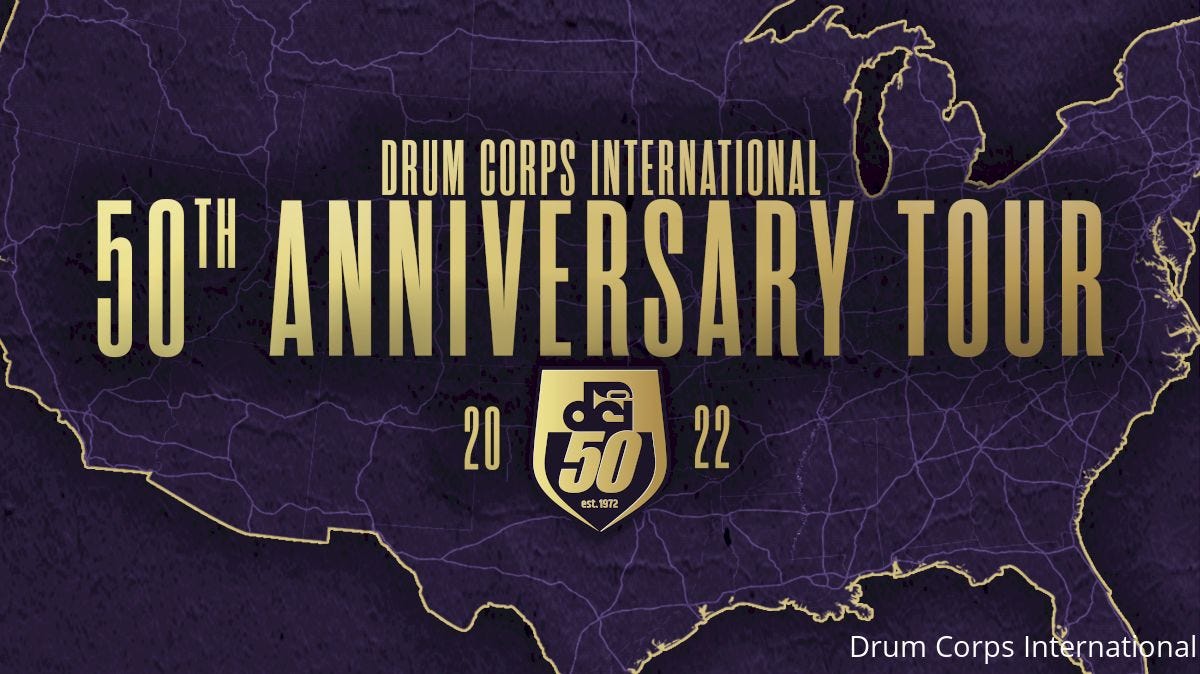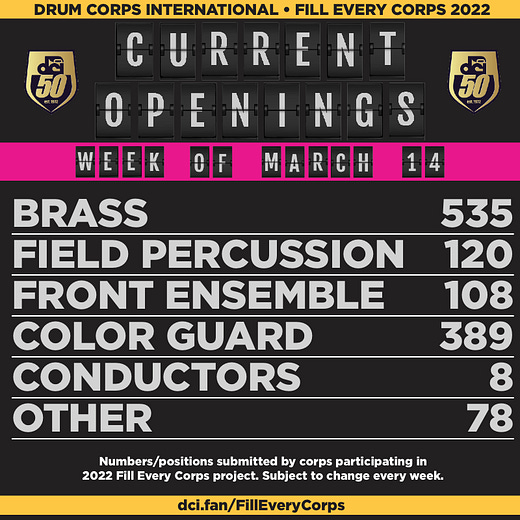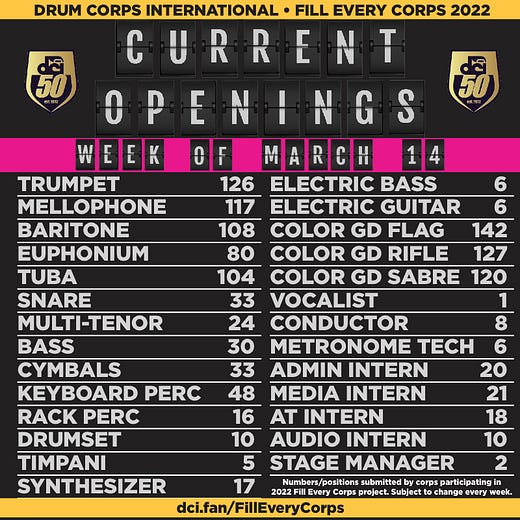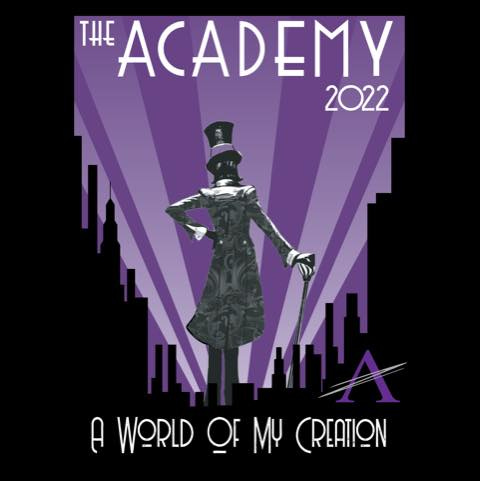A Lapsed Fan's Guide to DCI 2022, Part One
The beginning of a three part series covering what has changed since the last competitive season of DCI
Hey! It’s June 24th, and for the obsessed pageantry arts nerd, that means it’s time to switch into summer band mode, because for the first time in three years, it’s a competition day for DCI! Tonight is the first show of DCI’s 50th Anniversary Tour with Corps At The Crest - San Diego in Vista, CA. It’s been a few years since we’ve had a true full scale summer tour, so let’s get you caught up on all of the changes since the last competitive season in 2019.
IT’S BEEN THREE YEARS, WHY SHOULD I CARE?
Well, it’s still 154 perf… wait, 165 performers? Well okay. It’s still 165 performers sprinting across a football field, playing, marching, spinning and dancing their hearts out. They’re still going across the country, performing at the smallest High Schools and at NFL Stadiums, for you the fan to show your love and appreciation. There hasn’t been any fundamental changes to the activity since you watched it for the last time, and unless you’re the crankiest of DCI Dinosaurs who looks for any opportunity to jump ship, you’ll still love it.
RULE CHANGES
So, there was a lot of scuttlebutt about woodwinds coming into the fold over the past few years. Those fears haven’t come to fruition just yet. However, the long rumored corps size increase has come. The fear, and likely the reality, is that for the top corps, that just means that the students they’d take on to tour as alternates have become full members, and thus more alternate spots have opened up. In past years, the auditionees who just missed alternate status at the top corps have been recommended to other lower corps who hadn’t quite solidified their full complement of members, and this not only makes that potential pool smaller, it also puts the lower corps at a talent disadvantage, thus further increasing the divide between the haves and have nots in DCI. We’ll explore that a little in the next section, but when coupled with the arms race in tuition increases, this just makes it harder for any new or historically lower scoring corps to come in and show up the existing powers without significant outside backing.
WHY DID DCI BOMBARD MY TWITTER FEED WITH OPEN SPOTS?
Well, there’s more spots per corps this year! The limit was increased from 154 performers permitted on the field to 165. That may seem like a great thing for corps, being able to provide more opportunities to more students. Here’s the issue. Not everyone, especially your more regional corps, were hitting 154 before this. Lets get into why.
Many potential applicants after getting cut from their corps of choice don’t end up marching that season. That can be due to a few different reasons. In my experience, when I marched, the reason I auditioned and ended up marching where I did was due to convenience and access. Both of the corps I marched with held camps in my home state, and made it easy to show up, or if I couldn’t make it to a camp, would accommodate for that. That isn’t everyone’s experience. For example, if you’re in North Carolina, and you get cut from Carolina Crown, you might get an invitation to audition or to march at Legends. Getting to Michigan to try out or move in just might not be something that can happen for you, as opposed to getting a ride to Gardner-Webb for move-ins or to Fort Mill for a camp. In addition, you might not be able to afford to pay for audition or camp fees for multiple corps (quick aside, the experience can be fantastic at any level, and if that perception can be adjusted, DCI would certainly feel more accessible to potential members who’ve historically felt like they don’t have a place).
So the corps that have been in the top 6 consistently over the past few years, your BD, Bloo, and Crown, they’re still getting more of the high quality students that they’re accustomed to (which has a variety of factors associated with it) and therefore they’re closer to filling up than most, and can afford to be more selective with their auditionees due to the expectation of the experience that they’re known for providing.
For the corps that generally place from about 7th to 16th, your BK, Mandarins, Madison, Colts, and friends, there’s definitely been a few challenges they’ve been facing in the recruiting sphere. However as they generally recruit nationally, a lot of them haven’t seen as many of the changes in numbers as the corps below them. I will say that based on a lot of what I’m hearing from around the activity, don’t be surprised to see corps in this tier that get close to the member ceiling, but we also might see a few end up in the 100 to 120 range, member-wise.
The corps that consistently place below 16th or so at championships? That’s a whole separate ballgame, recruitment wise. There’s significant worry with the traditionally regional recruitment of these corps. Largely, these groups have generally foregone the national auditions that a lot of the higher placing corps have done in favor of more localized and regional audition camps. Sources at multiple corps that rely on this have reported issues with attendance, mostly due to how much COVID has disrupted high school bands, DCI’s strongest feeder over the past few decades. In addition, another way these corps have gotten their members have been cut lists from larger corps. The concern here is that a lot of the members they’d traditionally get off of the cut lists of higher placed corps aren’t getting cut anymore due to more spots available per corps as well as a smaller prospective field of active, engaged, and experienced high school band kids. When you combine that with the issues of local recruiting, these factors have made recruiting for the regional corps difficult in a way that the perennial World finalists don’t have to deal with. As of mid-May, the majority of Open Class corps were said to be hopeful to reach half of the maximum corps size. Corps that were medaling in previous years in Open are now struggling to reach 100 members.
STAFF MOVEMENT
Three years is a lot of time for a lot of things to change in an activity where corps can churn through three different educational and design teams in that time. What’s changed and who is where?
Well, let’s talk about Boston. You may remember that they made a huge move in 2017, propelling them up to a consistent top 5, and they’ve been on the doorstep of a medal since then, although they haven’t quite been able to crack it. This year, they promoted Gino to Assistant Corps Director (don’t worry, he’s still working with the hornline), and brought on Van Mathews to bump up their brass staff. For those who don’t know, Van was the director at historically one of the strongest BOA programs in Texas, LD Bell High School. He took over for current Music for All director Jeremy Earnhart when he left in 2009 until 2020, when he joined the ongoing great exodus of band directors. Boston’s had an excellent color guard the past few years, even winning two out of the three nights at the most recent World Championships, which has had a huge impact on their Visual and GE scores. What can they do to get the rest of the corps in sync and to that level? From what I’m hearing, this might be the Year of the Giant.
The Blue Knights have been dealing with a pretty sizable transition as they have a complete turnover in Music designers from 2019, with Jay Bocook shifting his role from Brass Arranger to becoming a consultant, in concert with his return to writing for the Cadets. Additionally, Kevin Shah and Mike Jackson departed, being replaced on the arranging front with Derrick Shannon and Chris Murphree. On the visual side, James Gow is returning as drill designer, along with Jay Murphy as consultant. Tracy Carter was hired away from Music City Drum Corps to become the new Guard Caption Head, as well as taking on the role of Visual Coordinator. Will their identity and niche as an artsy yet fairly accessible corps change with the staff? What will their new vibe be?
Phantom has taken a huge swing, bringing back JD Shaw, arranger for some of their greatest shows, after his 10 years spent writing for Vanguard. Coming back with him are notable names on the visual side such as Adam Sage and Tony Hall. Also on the visual side, they’ve hired Steven Estudillo, one of the reasons for Pacific Crest rising to the doorstep of finals over the past few seasons, to design their visual package. They’re hoping to recapture some of the magic that made them Phan Phavorites in the late 2000s and early 2010s, and take a step up performance wise to boot. If their preseason Concert in the Park performance is anything to go by, they’ve got that signature JD Shaw brass sound already, so finding their way back to the top 10 certainly doesn’t feel out of their grasp this year.
Shannon Berkstresser has stepped into the role of Program Coordinator for The Academy, as they’re seeking to re-enter finals for the first time since they had their first top 12 finish back in 2016. It’s been over 20 years since he’s been involved with DCI, having helped Boston break into Finals in 1999, though he has been active in the BOA and WGI since. The Academy over the past few years have not recaptured the spark that propelled them to getting over the finals hump 6 years ago. The design staff is largely the same other than Berkstresser and a couple of changes in the front ensemble and sound design. Can this new perspective of pure imagination return this corps to finals contention?
Vanguard made big news in mid-May, bringing on a new Visual Caption Manager in Noe Gomez just a week before moving in. This is the product of a third party investigation surrounding their previous VCM, Matt Hartwell, which led to his dismissal after 12 years on staff. A significant part of the visual staff resigned as a result, leading to a huge turnover on the visual educational team. In addition to this, Evan VanDoren has taken the reins over the brass writing, having been a successful director and arranger in the BOA and UIL realm, though this is his first opportunity to write for DCI. They’re the only consistent finalist corps who has made a significant change on the design staff since the 2019 season that we didn’t see at the celebration in 2021, making them more of an unknown than most other corps in their tier due to the factors mentioned above. However, they’ve returned three of the best designers in the activity, with Michael Gaines as Creative Director, and Paul and Sandi Rennick leading the Percussion staff. Will there be hiccups with the transition or will Gaines’ hand on the wheel help them find Nirvana?
Next is one of the more intriguing changes from 2019. Madison has completely gone in a different direction design wise, bringing in the Texas based combination of Jason Robb and Daniel Montoya Jr. for Program Coordinator and Music Arranger respectively (Editor’s note: DMJ is owner and founder of GEM). After a few years of searching for competitive success down a few different avenues, including retreads (2016) and an almost WGI Winds-esque show (2018), they’ve firmly put themselves into the camp of accessible and fan friendly with what has been announced of their 2022 program. This includes Drum Corps favorites such as Snarky Puppy and Tyondai Braxton, as well as newcomers to the scene such as Sarah Cothran, well known due to her work on the popular app Tik Tok, as well as Dolan Sipes, who as of the time of writing has only 36 monthly listeners on Spotify. Their show preview also heavily implies an art gallery, and Madison has explored similar concepts in the past, most recently with 2012’s “Reframed” where they used the frame work of Pictures at an Exhibition to explore a lot of their classics. This could be a way to call back to the past while looking to the present and the future of who the Scouts are. Oh, and speaking of the Scouts defining their new future, they became gender inclusive following the 2019 season, leaving Cavaliers as the last single gender corps. Will the expanded audition pool, consistent direction, and a return to a fiery Latin Jazz sound help Madison make the leap back to a consistent DCI finalist? That’s what the Scouts have bet on and they’re all in.
The Troopers have called on a few new designers as well as having some changes at the top of their educational staff. They brought back Tim Snyder to arrange their brass book and take over the role of program coordination. Tim is fresh off of a couple of highly successful years guiding the Mandarins horn line to finals appearances in 2018 (their first ever) and 2019. Lindsey Schueller was called up from Legends to take over Visual Design. She designed for the Kalamazoo based corps from 2014 to 2019, and interned at BAC in 2019 and 2021. On the educational side, Troopers retained Lauren Teel as their Percussion Caption Head, but brought in Mary Duerkop and Andrew Clark as Brass and Visual Caption Heads respectively.
Finally, let’s talk about the Cadets. It’s been a very difficult and frustrating last five years for the corps. On the field, they weren’t reaching the heights of corps in years past, and off the field, well… we all know about those issues. Fast forward to the Celebration in 2021, and they were one of the favorites of the crowd, having brought on alum and Matt Stratton from Bluecoats to lead their Brass Program, and brought back some of the staff that had them at the top of the activity, such as Tom Aungst, Jay Bocook, and in a consulting role, Jeff Sacktig. Cadets alumni, members and staff are all extremely excited about what is viewed as a righting of the ship. They’d like to put their issues, competitively and organizationally, in the rearview mirror.
You can find Part Two HERE
Saturday Night Lights is currently GEM’s Managing Editor. He has been involved in the Pageantry Arts for over a decade, as a performer at the highest level, an instructor, and a fan. You can find him on Twitter at @SatNightLites. He currently lives in Florida with his partner and their two dogs.














